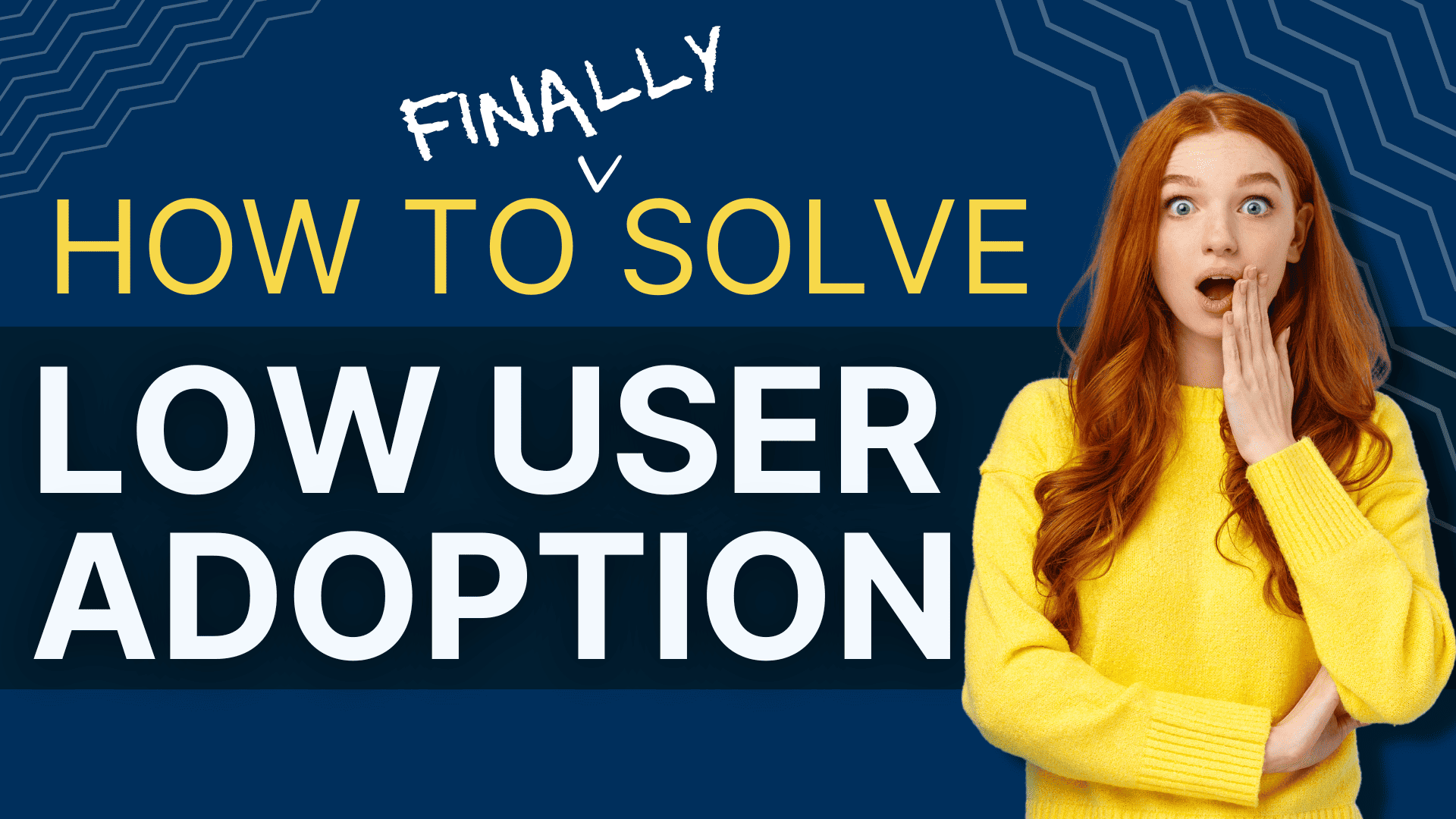Salesforce: Why User Adoption Is Low and What You Can Do About It

Introduction
Has the promise of Salesforce’s power become an echo of unfulfilled expectations in your organization? Are you left pondering why Salesforce, a titan in Customer Relationship Management (CRM), is gathering dust in your company’s toolbox?

With its diverse range of functionalities and endless potential for optimization, low user adoption can be a perplexing problem.
But fear not!
The good news is that it’s a challenge that can be overcome with some help, and that’s where we come in.
Let’s face it, Salesforce is no ordinary CRM. Its vast capabilities have revolutionized countless businesses, optimized processes, and helped organizations engage with their customers like never before. However, it’s common to hear stories of Salesforce not delivering the expected outcomes. This can lead to a lack of enthusiasm from employees, which in turn leads to underutilization of the tool.
But why does this happen?
There are various reasons why Salesforce user adoption is low, including poor communication, a lack of training, and uncertainty about how to use Salesforce’s extensive features best.
All is not lost, though, because some compelling strategies can vastly improve Salesforce user adoption, and we’re here to discuss those very strategies. So, let’s dive in and clear the fog on how to maximize your Salesforce investment.
Unveiling the Mystery: Reasons for Low Salesforce User Adoption

1. The Labyrinth of Complexity
The Problem of Complexity
Let’s face it – Salesforce is a complex and robust tool. Its architecture is intricate, and its features can be overwhelming for someone unfamiliar with the platform. As Salesforce Admins, one of the biggest challenges we face is getting our users to understand and appreciate the value that Salesforce brings to their work.
Unfortunately, the complexity of Salesforce can be its Achilles’ heel regarding high user adoption. Users might feel lost or intimidated by the interface, leading to disinterest and underutilization. For instance, entering data into Salesforce can feel like a tedious and mundane task to a new user, not adequately trained on the platform’s features and functionalities.
However, it’s important to remember that the complexity of Salesforce is not necessarily bad. It’s what makes Salesforce the powerful platform that it is.
But as Salesforce Admins, we must be mindful of our users’ needs and ensure they have the necessary resources to navigate the system seamlessly.

Resolve Complexity Through Training
One solution to this problem could be providing training and resources tailored to the users’ needs. For instance, if a user does not need specific features, records, or fields in Salesforce, those elements should be eliminated from their user experience and hidden from them.
Instead, we must identify features essential to their work and provide clear and concise training as part of the company’s new user adoption strategies.
Simplification of the Salesforce UI to Remove Complexity

Another solution is to simplify the user interface as much as possible. For example, creating custom objects can be overwhelming for new users, but new users can become more confident and efficient with the right training and a simplified interface. Simplifying the interface can go a long way toward easing new users’ fears and increasing new users’ adoption.
FREE CHECKLIST

Keep Stakeholders Engaged with This Checklist
Uncooperative stakeholders can derail a project, but with this free downloadable checklist, you can keep them engaged and ensure your project stays on track.
This comprehensive checklist provides tips to help you win over uncooperative stakeholders and keep them actively contributing to your Salesforce project.
Get started today by downloading the checklist here
2. Training Deficits: The Missing Link
The Problem of No End User Training
Let’s talk about the elephant in the room – the lack of proper training. This is one of the most common pitfalls many companies encounter when boosting Salesforce user adoption.
Most users feel they can only play ‘Chopsticks’ on a grand piano because they are not trained enough.
It’s not enough to provide new users with just a few minutes of basic intro to Salesforce and expect them to figure it out independently. Salesforce is a complex tool with many features, and without proper training, new users will be unable to understand how to leverage its full capabilities.
One staggering statistic we’ve come across is that up to 60% of Salesforce users do not use the software to its full potential. This means businesses are not getting the most out of their investment, leading to higher customer churn rates, acquisition costs, lower ROI, and missed growth opportunities over the customer’s lifetime.

So, as a Salesforce Admin, what can you do?
Ongoing Training to the Rescue

First and foremost, providing your users with comprehensive and ongoing training is essential to keep them engaged and knowledgeable. This can come in live training sessions, webinars, or video tutorials.
By providing your users with various learning opportunities, you can ensure they have the tools they need to unlock the full potential of Salesforce. This can be easily incorporated into your user adoption strategy process as you onboard new users.
Gamification as an Element of Training

Another approach that’s gaining popularity is gamification. By making learning fun, users will be more motivated to learn and engage with Salesforce. This can involve challenges, quizzes, and leaderboards that incentivize users to learn more about Salesforce and compete with their colleagues.
SNAG THESE FREE RESOURCES!

Struggling to Manage Your Salesforce Projects?
Master Project Management With Our Expert Resources for Salesforce Admins.
Check out some of these FREE RESOURCES, templates, ebooks, and courses to take your project management skills to the next level and take control of your Salesforce career!
3. Ineffective Change Management
The Problem of Stubborn Users

Let’s face it, change can be tough, especially when learning a new platform like Salesforce. As a Salesforce Admin, you know that one of the biggest obstacles to user adoption is resistance to change. While some users may be open to new technology and excited to learn, others may be more hesitant and resistant to the idea altogether.

But why does this happen?
First, it’s important to remember that adopting Salesforce is a big change for many users. It requires learning a new system, understanding new processes, and oftentimes, abandoning the old ways of doing things. This can be uncomfortable and overwhelming, causing some users to resist or reject the new platform.
Addressing Change Management Through End User Support

That’s where effective change management comes in. It’s important to provide your users with the resources, support, and training they need to make the transition as smooth and painless as possible. This includes everything from clear communication about the new system to offering hands-on training and support for those who need it.
Solving Change Management by Addressing Their Concerns
It’s also important to address any concerns or hesitations your users may have about the new system. Take the time to listen to their feedback and provide clear and compelling reasons why the new system benefits them and the organization. This can help ease their fears and increase their motivation to learn and use the new system.

The Virtue of Patience
Finally, be patient and persistent in your efforts to promote user adoption.
Change takes time, and everyone learns at their own pace. Keep providing your users with the resources, support, and encouragement they need, and eventually, they’ll get the hang of it.

4. Misalignment Between Business Processes and Salesforce Implementation
The Problem of Unsupported Business Processes
Have you ever experienced the pain of using a software system that doesn’t fit your business operations? It’s like trying to walk in shoes two sizes too small – the discomfort is real.
This mismatch can be a significant barrier to user adoption in Salesforce.

Salesforce is a highly customizable platform, and it’s essential to align the implementation with your business processes to maximize its potential. But when your Salesforce setup doesn’t reflect your way of working, it can lead to confusion, inefficiency, and decreased user engagement.
One common example of this misalignment is when users jump through hoops to complete tasks, like switching between different systems or manually entering data in multiple places. If your team feels they’re wasting time on redundant or irrelevant tasks, they’re less likely to use Salesforce and may even look for workarounds to avoid it altogether.
Another issue can arise when the data architecture in Salesforce doesn’t match your business logic. For instance, depending on the user’s role, you may have multiple business units or territories with different data access requirements. If your Salesforce setup doesn’t reflect this hierarchy, users may struggle with a cluttered view of irrelevant information or face barriers to accessing the data they need.

Updating the Salesforce Configuration
Optimizing Salesforce’s implementation to match your business processes is crucial to increase user adoption. Regularly review your business use cases and workflows to identify friction points and pain points and adjust your setup accordingly. Consider involving users in this process, as they can provide valuable feedback and insights into their day-to-day tasks.
Addressing these misalignments can create a Salesforce system that empowers users and aligns with your business goals, increasing customer success, team engagement, and productivity.
Crafting the Compass: Strategies to Improve Salesforce User Adoption
Now, let’s venture into uncharted territories to discover solutions to turn your Salesforce experience around.

1. Simplify the Maze: Streamline Salesforce’s Interface
Salesforce can sometimes feel like a maze, with endless tabs and subtabs, making it difficult for users to navigate and find what they’re looking for. This can lead to frustration and a low user adoption rate. A great way to combat this is by streamlining Salesforce’s interface to make it more user-friendly.
One effective strategy is to tailor the interface to users’ roles and needs. For example, sales reps would find it more helpful to have a dashboard showing their leads, opportunities, and tasks. In contrast, customer service reps would benefit from having access to cases, service contracts, and knowledge articles. By creating custom apps and dashboards, users can easily access the tools and information they need to do their job.
Another way to simplify the interface is by reducing clutter and hiding unnecessary tabs and subtabs. This can be done using Salesforce’s customizations, such as page layouts and object permissions. By doing this, users will feel less overwhelmed and can focus on their specific tasks without distractions.

It’s important to remember that simplifying Salesforce’s interface doesn’t mean eliminating functionality. It’s about making it easier for users to find what they’re looking for and reducing the clutter that can lead to frustration. Creating a more streamlined interface can increase user adoption and drive more value from your Salesforce investment.
2. Invest in Comprehensive Training
If you want to see an improvement in Salesforce user adoption, one of the best things you can do is invest in comprehensive training for your team.
Some users may be hesitant to explore the platform in-depth, preferring to stick to the basics and avoid getting lost in the maze of features and functionality.

Comprehensive training can help alleviate these concerns, empowering users to navigate Salesforce confidently.
This can help them discover the platform’s full potential, including the many hidden features and customizations that can be tailored to meet your organization’s unique needs.
But what should a comprehensive training program look like?
It should be ongoing, for one thing.
Training sessions should be held regularly and cover various topics, from basics like navigating the platform and managing data to more advanced topics like automation and reporting. This will help the users learn to build their knowledge and skills over time rather than being overwhelmed by a single, all-encompassing training session.
It’s also important to make training as interactive and engaging as possible. Don’t just rely on lectures and slideshows – incorporate hands-on exercises, interactive quizzes, and plenty of opportunities for questions and discussion. This can help to keep users engaged and encourage them to take an active role in learning and exploring the platform.

Finally, ensure that training is tailored to your organization’s needs. Consider creating tracks for different user groups, such as sales, marketing, or customer service. This will help ensure everyone gets the training they need to succeed in their particular role.
Investing in comprehensive training can make a huge difference in Salesforce user adoption.
By providing your team with the knowledge and skills they need to navigate the platform confidently, you can help them see its full potential and unlock new levels of productivity and efficiency.
3. Effective Change Management: The Beacon in the Storm
Change can be difficult and uncomfortable, and users may resist new technologies and processes that disrupt their routines. Salesforce is no exception. As a Salesforce Admin, you must manage change effectively to improve user adoption rates.

Effective change management is the beacon in the storm. You can’t just introduce Salesforce and leave your existing users alone to fend for themselves. They need guidance and support to navigate this new sea of data and functionality. You must develop a comprehensive change management plan that addresses potential pitfalls and builds buy-in from your users.
Start your successful user adoption journey by assessing your organization’s current state of user adoption. What specific challenges are your users experiencing? Identify their pain points and address them in your change management plan. Next, communicate the benefits of Salesforce and your user adoption strategy to your users. They must understand the potential ROI, business value and impact, customer lifetime value and relevance to their roles.
Training is essential to successful Salesforce and user adoption strategies. Plan and execute effective training programs tailored to each user’s role, experience level, and learning preferences. Use a combination of in-person and online training, including webinars, videos, and interactive simulations.

Another key component of effective change management is aligning Salesforce with your organization’s strategic goals. Salesforce can help you achieve specific business objectives, such as increasing revenue, enhancing customer satisfaction, and improving sales productivity. Communicate these goals to your users and show them how Salesforce can help them achieve them.
Finally, don’t forget to celebrate successes. Recognize users who have left their comfort zones and embraced Salesforce. Share their customer success stories with the team and the rest of the organization to motivate and inspire others to follow suit.
4. Align Salesforce Implementation With Business Processes
Have you ever wondered why your Salesforce implementation isn’t living up to its potential? You may have fallen into the trap of conforming your business processes to Salesforce instead of having Salesforce fit into your business processes like a glove.
It’s crucial to understand that Salesforce is a tool to enhance your business, not the other way around. If Salesforce isn’t tailored to your business processes, it could create hindrances and lead to low user adoption rates.

So how exactly do you align your Salesforce implementation with your business processes? The first step is to fully understand your business’s unique needs and workflows. Take the time to identify areas where Salesforce can streamline processes and improve efficiency.
It’s also important to involve your team in the implementation process. Ask for their input and feedback and consider their suggestions for improvements. By involving your team, you’ll not only receive valuable insights, but they’ll also feel a sense of ownership and engagement with the tool.
Lastly, regularly assess your Salesforce implementation to ensure it’s still meeting the needs of your business. As your business evolves, so do your needs, and Salesforce should adapt accordingly. You’ll continue to see high user adoption rates and improved efficiency by consistently evaluating and making necessary adjustments.
In summary, aligning your Salesforce implementation with your business processes is crucial for success. By keeping Salesforce tailored to your unique needs, involving your team, and regularly assessing and adapting, you’ll enhance efficiency while avoiding potential hindrances. Remember, Salesforce is here to enhance your business, not the other way around.
Conclusion

Regarding CRM, Salesforce is among the best, if not the best, options on the market. Nonetheless, its immense capabilities and depth can seem overwhelming to the uninitiated, leading to less-than-stellar user adoption. However, by identifying the common pitfalls that lead to low user adoption success and engagement and utilizing potent strategies to address these issues, you can guarantee that Salesforce is a central and indispensable element of your organization’s product or service side’s infrastructure.
One possible issue contributing to low user engagement is a lack of education and training regarding the platform. Salesforce is a complex system with multiple features and functions, and knowing where to begin for the uninitiated can be challenging. By providing comprehensive training and resources to users, Salesforce admins can empower them to feel confident and comfortable with the tools and applications available.

Another aspect contributing to low user engagement is a lack of customization and personalization within the platform. Salesforce is a highly customizable system where specific features can be tailored to the specific needs of individual users or teams. Users who cannot personalize their experience may become uninterested or hesitant to engage with the platform. Enabling customized settings and curated dashboards can go a long way to encourage users to utilize Salesforce daily.
Ultimately, it’s essential to recognize that improving the user, customer journey and adoption process is a journey, not a destination. It is a continuous process that is continually evolving and requires ongoing assessment and iteration. By staying attuned to user concerns and feedback, implementing robust training systems, and providing engaging, personalized user experiences, you can ensure that the customer journey with Salesforce becomes an indispensable part of your business machinery. So don’t wait any longer. Start enhancing your Salesforce user engagement today!

FAQs
1. Why Is User Adoption Important for Salesforce?
Regarding Salesforce, improving user adoption here is crucial for achieving business success. After all, Salesforce is not just a mere CRM tool but a comprehensive platform encompassing every part of your company’s operations. Every data point, interaction, and transaction is consolidated within Salesforce, becoming the backbone of your organization’s decision-making process.
Low user adoption rates ultimately translate into unused licenses, wasted investment, and poor return on investment (ROI). This is especially true considering that Salesforce is not the cheapest solution available. Having an underutilized Salesforce platform essentially becomes a sunk cost for your organization, which puts a dent in your bottom line.
But the importance of an effective user adoption strategy for Salesforce goes beyond ROI. When your team is not fully leveraging the platform’s capabilities, gaps in data, poor collaboration, and inaccurate reporting can become a reality. These issues may lead to poor customer experiences, ultimately impacting your company’s reputation and revenue.
Boosting user adoption by implementing an effective user adoption strategy can help your customer success team avoid these negative outcomes. By increasing Salesforce usage, you can streamline your organization’s processes, improve collaboration, and obtain valuable insights from data. This leads to increased accuracy, reduced errors, and better customer experiences.

2. How Can We Measure Salesforce User Adoption Rates?
If you’re puzzled about whether or not your Salesforce users are engaging with the platform, you must start measuring Salesforce user adoption rates. In doing so, you can gain better insights into user behavior and take action to increase engagement.
One of the easiest ways to measure Salesforce user adoption rates is by tracking login frequency. If new users log in regularly, it indicates they’re actively using the platform. On the other hand, if you’re noticing a significant drop in login frequency, then it may be time to re-evaluate the training and support you’re providing active users.
Another metric to consider is record creation. This metric measures how many records are created in Salesforce by users regularly. Low record creation rates may indicate that users find navigating the platform challenging or not seeing the value in using Salesforce.
Feature usage is another important metric to track, as it can help identify which features are used most frequently. By doing so, you can focus on training users to understand the platform more comprehensively while identifying areas where you can improve the user experience.
Measuring Salesforce user adoption rates isn’t rocket science. However, it does require a concerted effort from Salesforce admins to collect and analyze user journeys and data. By doing so, you’ll be able to identify areas of weakness and take action to improve user adoption rates over time.

3. How Does Training Improve Salesforce and User Adoption Metrics?
Incorporating comprehensive training programs can significantly impact user adoption metrics and overall Salesforce success. Training sessions educate users on how to use Salesforce tools to their advantage, allowing them to delve deeper into its features, thus enabling them to perform their jobs more efficiently.
With training, users will understand the various functionalities of Salesforce, including dashboards, reports, and the importance of data maintenance. They will also learn how to customize the system to their needs and collaborate effectively with other users. By mastering these features, users will become more confident and adept at using the system, leading to higher user adoption rates.
Moreover, training can enhance user satisfaction as users become comfortable with the system, leading to higher engagement. This is because they can easily complete tasks, ultimately making them more productive and allowing them to achieve their goals more effectively.
Another critical aspect of training is that it fosters a culture of continuous learning, where users can continually improve their skills to get the most out of Salesforce. This approach can significantly improve user adoption metrics, increasing user satisfaction, productivity, and success.

4. Can Customization Improve Salesforce User Adoption?
Customization can make all the difference regarding Salesforce and user adoption strategy. By tailoring the platform to users’ specific roles and needs, you can create a more intuitive and user-friendly experience, leading to higher user adoption processes and rates and greater success in achieving your user adoption strategy and goals.
Too much customization?
One of the main reasons why Salesforce user adoption may be low is that users may find the platform overwhelming or difficult to navigate. This is especially true for organizations that use Salesforce to manage complex processes and workflows. By customizing the platform to align with users’ specific needs, you can streamline the user experience and eliminate any unnecessary steps or fields that may be confusing.
Customization can be achieved in several different ways. For example, you can create custom page layouts that display only the information and fields relevant to specific user groups or roles. You can also use validation rules and custom objects to ensure data is entered accurately and consistently across the organization. By implementing these customizations, you not only improve the user experience but also help to maintain data integrity and accuracy.
Another important aspect of customization is training and education. When introducing new customizations to the Salesforce platform, it’s important to provide users with clear instructions and resources to help them understand how to use the new features. This may involve creating training videos, hosting webinars, or providing one-on-one training sessions for users who need extra help.
In addition to improving user adoption rates, customization can drive greater productivity and efficiency across the organization. By streamlining processes and eliminating unnecessary steps, users can focus on their core tasks and achieve their goals more quickly and effectively. This can help create a positive feedback loop where users feel more confident and comfortable using Salesforce, leading to even higher user adoption rates.

5. How Can We Maintain High Salesforce User Adoption Rates Over Time?
Maintaining high Salesforce user adoption processes and rates over time can be challenging. However, with the right approach, it is possible to keep users engaged and ensure that they continue to use the platform to the best of their capacity. Here are the strategies you can implement to keep the Salesforce user adoption process and rates high:
1. Regular Training
Regular training sessions will help your employees better understand Salesforce, boosting their confidence.
2. Ongoing Support from Active Users
This support system demonstrates the potential business value of Salesforce and will cultivate a collaborative environment among your employees.
3. Continuous Customization Based on User Feedback
Implementing small changes based on user feedback can go a long way in fostering employee satisfaction, trust, and engagement.
4. Run Quick-Pulse Surveys
This feedback can help you improve their Salesforce experience and drive product adoption.
5. Measure Your Adoption Success
By understanding your Salesforce and user onboarding adoption strategies and trends, you can take the necessary steps to improve and optimize user onboarding in your Salesforce environment, ultimately ensuring a high user adoption rate over time.
